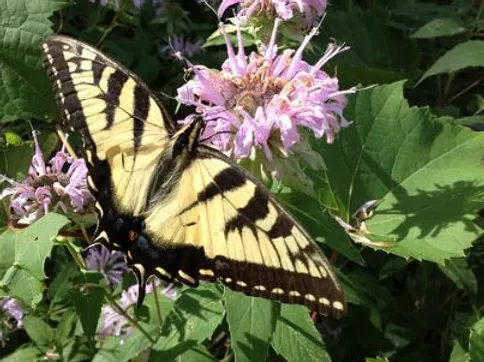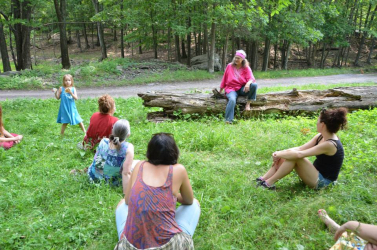
INDEX | HEALING WISE | Q & A with SUSUN | GREEN BLESSINGS
THE LIBRARY | PEOPLE MAKING CHANGE | GODDESS ART GALLERY
Green Blessings ...
with Susun Weed
Bee Balm Sisters: The Monardas

Allow me to introduce you to the beautiful bee balm sisters, also know as the majestic Monardas. They come in many bright colors and have the most amazing scents. Yes, you’re right, they are part of the mint family.
Gardeners love the bee balm sisters for their study self-reliance. Plant them almost anywhere (from British Columbia to Texas and from the Rocky Mountains to the Atlantic) and you can forget them . . . until they delight you with masses of aromatic blooms tended to by dozens of bees, butterflies, and hummingbirds.
Herbalists love the bee balm sisters for their ability to ease digestive and respiratory woes, and counter inflammation, too. A cup of hot or cold bee balm tea, of the fresh or dried leaves or flowering tops, or several spoonfuls of bee balm vinegar can help release gas from the intestines (carminative), encourage gut flora (digestive), move mucus in the lungs (expectorant), encourage sweating (diaphoretic), counter fevers (antibacterial febrifuge), counter cramps (antispasmodic), strengthen the heart (cardiac tonic), promote health (antioxidant scavenger), help induce sleep (mild sedative), and improve urinary flow (mild diuretic).
The bee balm sisters help those troubled by indigestion, colic, gas pain, flatulence, diarrhea, nausea, vomiting, bloating, colds, sore throat, fever, headache, sinusitis, sore eyes, nosebleed, eczema, chills, bleeding gums, tooth decay, parasites, and backache. Breathe the fragrant steam of any bergamot to open to lungs, promote deeper breathing, counter bronchitis, and relieve lung congestion. Try a poultice against bee stings and headaches, skin eruptions (measles, chicken pox).
Scarlet bee balm, Oswego tea (Monarda didyma)
This is my favorite of the Monardas, and often the most difficult to find. It is considered endangered or threatened in parts of its range. The fragrance is neither minty nor oregano-y, neither citrus nor thyme, but partakes of all these with a soft and subtle sweetness. The long-lasting flower is a clear red with a hint of purple. Scarlet bee balm is my secret ingredient in comfrey infusion. One stalk of dried herb, with leaves and flowers is added to one ounce of dried comfrey leaf and infused in a quart of boiling water overnight. Be sure to use the scarlet bee balm, not the others; they are too rich in volatile oils. Some books suggest that scarlet bee balm gets bitter after it flowers, but I have not found that to be the case.
Wild Bergamot (Monarda fistulosa)
This is the most common wild Monarda. It contains more thymol and oreganol than Oswego tea. This makes it more interesting as a medicine – and much stronger tasting – than its more red-flowered sister. Does this one become bitter if harvested after the flowers open? It is too late this year to test this idea out, but I shall endeavor to do so next year. I’ve always harvested the whole flowering top, dried it until crisp, crumbled the leaves and petals off the stalk and then used it in soups for a powerful antioxidant and a flavor enhancer. A wild bergamot leaf poultice was used by native people’s to dry up pimples and other skin rashes. Herbalists in Colorado tincture their strongly scented, high altitude, powerful tasting wild Monarda and use it as an antiviral and anti-infective.
Cultivated Bergamot (Monarda x)
The most commonly sold Monarda cultivars seem to be a cross between the lovely lilac fistulosa bergamot and the stately red didyma bergamot, with the resulting plants having far more oreganol and thymol than the pale purple fistulosa and not nearly as nice a taste as the scarlet red didyma. I admit to finding the colors of the cultivars rather off putting as well. Like the scent and the taste, the concentration of oils in cultivated Monardas is over the top. Too much, I say.
Horsemint (Monarda punctata)
I have yet to find this Monarda growing near to me, so no photo of it, but this plant is hard to miss. It looks like the other bergamots, but with wide-jawed yellow flowers dotted with small purple spots and held by bright white or lilac bracts. This one is loaded with volatile oils and is prized as a medicine. It contains more thymol than thyme itself does. I think I will buy a few plants of punctata from Richter’s in Ontario and see if I can get it to grow in my garden. (They probably have didyma too, if you are looking for it.)
........

|
 The Wise Woman Center exists to re-weave the healing cloak of the Ancients. This land is sacred, it is a safe space for women, and a place for the teachings of the Wise Woman way. The Goddess lives here, as do goats, fairies, green witches, and elders. The Wise Woman Center exists to re-weave the healing cloak of the Ancients. This land is sacred, it is a safe space for women, and a place for the teachings of the Wise Woman way. The Goddess lives here, as do goats, fairies, green witches, and elders.
Located between Woodstock and Saugerties, 5 miles from the NYS Thruway, the Wise Woman Center is easily accessible while private enough for nude swimming. You'll receive a map and directions when you register.
Incredible wild-food vegetarian meals are included with all workshops. Two - and three-day workshops (limited enrollment) include camping or indoor sleeping space and meals.
Click to learn more |
|
|
Wise Woman Herbal Ezine is sponsored by
www.susunweed.com and www.wisewomanbookshop.com
HEALING WISE | Q & A with SUSUN | GREEN BLESSINGS
THE LIBRARY | PEOPLE MAKING CHANGE | GODDESS ART GALLERY
©Susun
Weed -Wise Woman Center
~ Disclaimer & Privacy Policy ~
|

 The Wise Woman Center exists to re-weave the healing cloak of the Ancients. This land is sacred, it is a safe space for women, and a place for the teachings of the Wise Woman way. The Goddess lives here, as do goats, fairies, green witches, and elders.
The Wise Woman Center exists to re-weave the healing cloak of the Ancients. This land is sacred, it is a safe space for women, and a place for the teachings of the Wise Woman way. The Goddess lives here, as do goats, fairies, green witches, and elders.

